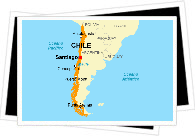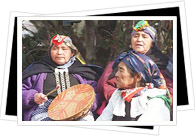
The Republic of Chile lies between the Andes mountains and the Pacific Ocean on the south western coast of South America.
It stretches about 4300km from north to south, has an average width of 177km (110 miles) and its territory also includes the Juan Fernandez Islands, Easter Island, Desventurados Islands, Isla Salas y Gomez and nearly 500,000 square kilometres in Antarctica (claimed). The capital and largest city is Santiago where 80% of Chile's population of fifteen million reside.

When the Europeans arrived in Chile, it was inhabited to the north by the Inca (Quechua) and the Araucanians (Mapuche) who controlled much of the remainder of the country. The Araucanians were nomadic farmers, but also warriors and stopped the Inca empire from taking over their lands. They were able to stave off the Spanish for a great number of years, wiping out many of the European settlements shortly after they were established, to the extent that in some areas of Chile, the Europeans did not return again for two centuries. Eventually Chile became independent of Spain in 1810.
80% of Chile's land is hilly or mountainous. The Andes mountain range is a relatively young one and contains some 620 volcanoes of which many are active. Chile is also highly prone to earthquakes and in the last century experienced 28 earthquakes of 6.9 or higher on the Richter scale. Because of this, since the tremendous earthquake in 1960, Chile has enforced a building code so that its buildings are constructed to be earthquake resistant.

During the 1980's the production of wine in Chile increased six-fold from 12 wineries in 1995 to over 70 a decade later. Nowadays Chile sits in tenth position for its wine exports around the world. It produces 28% of the world's copper from its mines and exports 50% of its fruit yields to the USA and Europe. In the USA it is estimated that 25% of grapes and 35% of kiwi fruit eaten there are imported from Chile. It is also a major seafood provider due to its vast coastline of 6435km (3998 miles).
Chile can boast 32 national parks and just under fifty national reserves. Due to the geography of the country, tourism exists in a variety of locations and forms: Visiting the Atacama Desert, which has never seen rain in recorded history, or heading south to the glaciers and home of the penguins, there is also the lake district of lakes, waterfalls and volcanoes not to mention water sports and ski resorts. Santiago is home to both Colonial and modern architecture. It is a clean city with average winter (June) maximum temperature of 14 degrees Celsius and in the summer (January) this increases to a very warm 29 degrees.
Further information about Chile is available by clicking on the above tab options and also within the cultural and visits menu options.